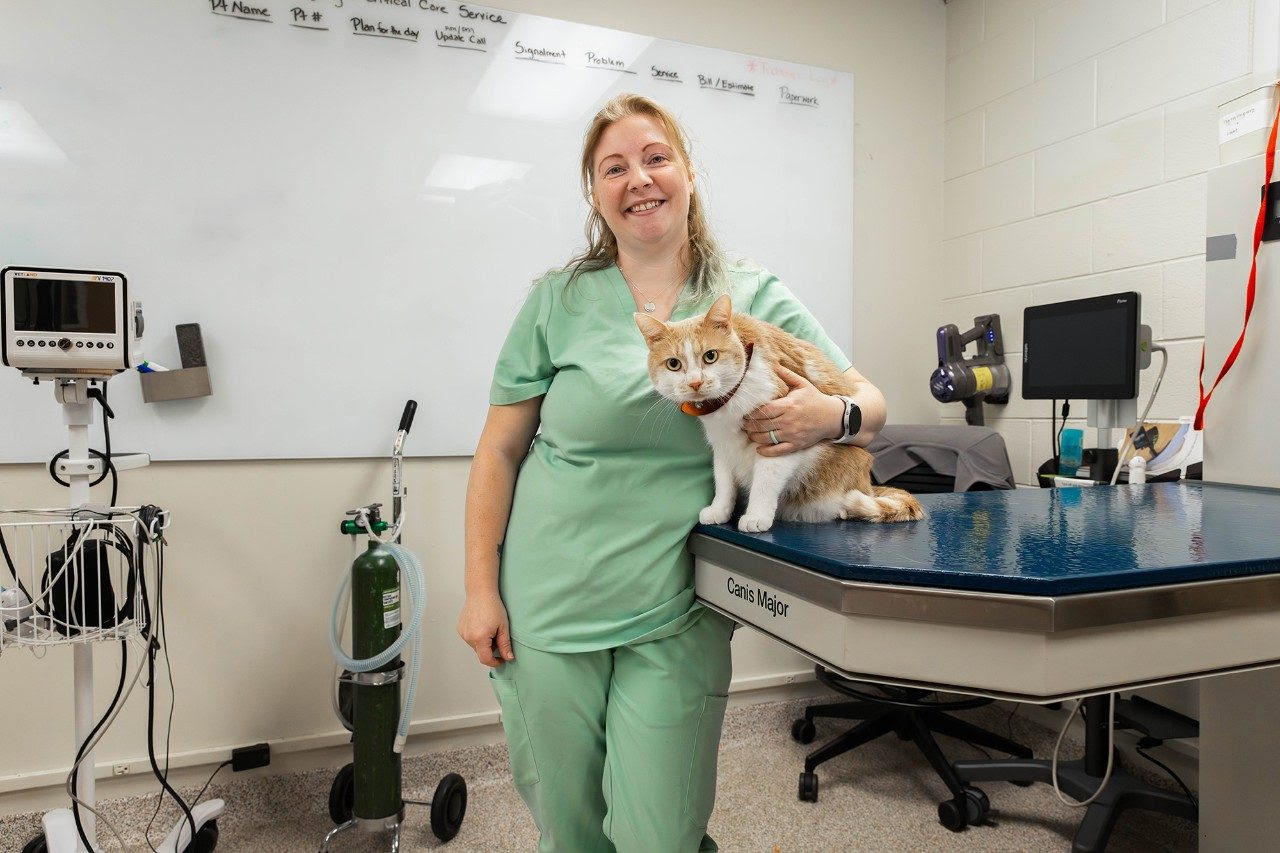
Amidst the beeping monitors and busy footsteps of the bustling Veterinary Teaching Hospital, an extraordinary lifeline exists — a blood bank, where like their human counterparts, dogs and cats regularly donate blood to support pets in the community.
“Animals sometimes require blood due to specific medical conditions or injuries, and without a readily available blood supply, their lives are at risk,” said Raeann Foster, clinical instructor of emergency and critical care medicine and director of the Veterinary Teaching Hospital blood bank.
This is where the blood donor program plays a crucial role. Just like with humans, dogs and cats also have different blood types, which is why it’s important to have as many donors as possible. Pets owned by students, faculty, staff, and the community participate in the program, but more cats and dogs are needed.
Emergency Veterinary Technician Tiffany Luci sees the impact of the blood bank on a daily basis, which is why she enrolled both of her cats as donors. Her orange and white domestic short-hair, Marigold, is an ideal donor.
“She’s a very well-behaved cat and doesn’t get stressed out by the hospital environment,” Luci said. “Being in emergency, I see the need for cat blood and that’s why we donate.”
The program functions much like its human counterpart, using regular blood work, preventive measures, and vaccines to ensure the health of the donors. A single donation can help save multiple lives, as the blood is separated into packed red blood cells and plasma. Frozen plasma can last for years, supporting research and treating diseases such as parvovirus in puppies.
Dog and cat donors must meet certain age and weight requirements and pass health screenings. The temperament of the donor animals also plays a significant role in the success of the program. Foster and her team are diligent about behavior screening to ensure that the donors are comfortable and content during the process.
“The well-being and quality of life of the donors are just as vital as saving lives with their contributions,” said Foster.
Sheree and Darrell Coulter, owners of a seven-year-old boxer-pitbull mix and canine blood donor named Topper, spoke passionately about the impact of the program.
“It’s amazing,” said Sheree Coulter. “It helps full-grown dogs who need surgery, and it helps the puppies too when they can’t nurse.”
“People know about human blood donors through the American Red Cross,” Darrell Coulter said, “but they don’t often think about what happens to the animals.”
Topper has made several donations and his owners spoke about how much he enjoys getting to see the staff at the teaching hospital every few months. On average, each pet makes four to six donations per year.
Heidi Phillips, a lab technician at the Veterinary Teaching Hospital, supports the blood bank in multiple ways. Her lab stores the donated blood, and her two Weimaraners, Eva and Hazel, contribute to the supply.
“I used to donate blood myself,” said Phillips, “and I thought that it’s so neat that the dogs can give back to their kind. I used to have Jack Russell terriers who were too small to donate, but as soon as my larger dogs became qualified, we signed up.”
“Dogs don’t have to be purebreds or show or hunting dogs like mine to donate. Almost all breeds and mixes are welcome and could make awesome donors, if they all meet the criteria.”
The demand for blood can fluctuate which is why it is critical for the program to have a robust list of participants. “We had a spell where we were using a lot of blood,” Phillips said, “and it hurt me to tell them we didn’t have any available.”
During times of critical need, the hospital calls on owners in the program to come to the hospital for emergency blood draws, which can happen at any hour of the day, but owners like Phillips repeatedly step up and provide support.
Enrolled pets receive additional benefits, including annual exams, vaccinations, and preventatives while active in the donor program.
“It’s nice, because, you know, for my two girls, it’s close to $300 to have all that testing done,” Phillips said. “And with them being show dogs and out in the field, those preventatives are something that I keep them on all the time. But it’s not the main reason we donate.”
Like Phillips, owners opt to register their pets in the program because of their compassion and willingness to contribute toward saving the lives of others.
The blood bank is currently recruiting cats and dogs to enroll in the blood donor program. Interested owners should fill out an application at vth.vetmed.vt.edu/bloodbank to begin the screening process.
Requirements for dogs: 1-8 years old male or female, 55-plus pounds (lean body weight), quiet temperament, and no history of blood transfusion.
Requirements for cats: 1-8 years old male or females that have not had kittens, 11-plus pounds (lean body weight), quiet temperament, no history of blood transfusion, indoor only; and housemate cats must also be indoor only and fully vaccinated.
Andrew Mann for Virginia Tech

